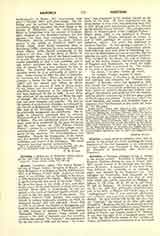

Ariosto, Ludovico, called “The Italian Homer” the son of Nicoll Ariosto, Governor of Reggio, and Daria Malaguzzi, b. at Reggio in Emilia, September 8, 1474; d. at Ferrara, June 6, 1533. Ludovico was the eldest of ten children, and on the death of his father, in 1500, became head of the family. When nine years of age he composed and acted in the fable “Tisbe”. He gave five years to the study of law, and when twenty years old devoted himself to Greek and Latin authors. From 1503, or thereabouts, he was attached to the court of Cardinal Ippolito d’Este, but in 1518 he fell into disfavor with his patron. The Cardinal‘s brother, Duke Alfonso, then employed Ariosto in various diplomatic missions, in which he conducted himself with tact and skill. From 1522 to 1525 he governed the district of Garfagnana and freed it from the robber-bands which had infested it. In 1530, perhaps, he married a Florentine widow, Alessandra Benucci. Ariosto wrote sonnetti and canzoni in the style of Petrarch, and five comedies, of which the earliest, “La Cassaria”, was represented for the first time in 1509, and the latest, “La Scolastica”, was completed by his brother Gabriel on the death of the poet. Of more importance are his seven Satires in terza rimes, and extending from 1517 to 1531, giving much information on his own life and laying bare the vices of the time. The principal foundation of Ariosto’s glory is the “Orlando Furioso”. Begun about 1505, it was published in Ferrara, April 21, 1516. Ariosto continued to correct it, and in 1532 published the second, enlarged and definitive, edition. The poem was dedicated to Cardinal Ippolito. At first reading it appears to be a disconnected patchwork of fragmentary adventures following upon each other in bewildering variety; but on close analysis it becomes apparent that the episodes are spun around three principal incidents: Paris besieged by the Moors, the rage of Orlando, and, as the central subject, the love and marriage of Ruggiero and Bradamante, by which the origin of the house of Este is accounted for. The subject of the poem is expressed in the opening lines;
Le donne, i cavalier, l’arme, gli amori, Le cortesie, I’audaci imprese io canto.
It is the glorification of chivalry in all its elements, and continues and completes the “Orlando Irmamorato” of Boiardo, which had appeared in 1495, but, though the “Innamorato” is its foundation, it far surpasses its forerunner in perfection of style and form, variety of incident, the gay and brilliant mingling of the romantic and medieval with the classical, and the artistic interweaving of the two great cycles of Charlemagne and Arthur. It has been called “the most beautiful, and varied, and wonderful poem of romances that the literature of the world can boast of” (G. Picciola).
JOSEPH DUNN

